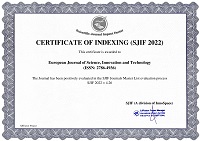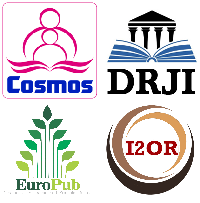Feasibility of Radiation Schemes to Predict Extreme Temperature Conditions over Bangladesh
Abstract
An extreme temperature is a weather phenomenon that is distinguished by marked cooling or heating of the air, or with the invasion of very cold or hot air, over a large area. The present study is associated with the simulation of regional climate using the Weather Research and Forecasting (WRF) model that was experimented through 30 different combinations of radiation parameterization schemes over Bangladesh. The intention was to investigate the response to the radiation parameters schemes for dynamic down-scaling of climatic variables. The predicted temperature of 30 different WRF setups were analyzed and compared with the Bangladesh Meteorological Department (BMD) recorded data and were found sensitive to the radiation physics on the basis of Root Mean Square Error (RMSE) at 2-meter air temperature on 02-05 January 2019, 02-05 February 2019 and 28-31 December 2019 for Cold Wave (CW), and 24-27 April 2019, 09-12 May 2019 and 19-22 May 2019 for Heat Wave (HW) at 34 stations over Bangladesh. We conclude that the Rapid Radiative Transfer Model (RRTM) for long wave and Dudhia for short wave schemes are the most appropriate combinations to simulate in the extreme temperature. Using the selected combinations of WRF parameterizations to downscale the extreme weather events, which showed good agreement with the reference data. It was suggested WRF parameters from this study could be utilized for regional climate modeling of Bangladesh.
References
Ciais, Ph., Reichstein, M., Viovy, N., Granier, A., Ogée, J. Allard, V. Aubinet, M., Buchmann, N., Bernhofer, Chr. Carrara, A., Chevallier, F., Noblet, N. De., Friend, A. D., Friedlingstein, P., Grünwald, T., Heinesch, B., Keronen, P., Knohl, A., Krinner, G., Loustau, D., Manca, G., Matteucci, G., Miglietta, F., Ourcival, J. M., Papale, D., Pilegaard, K., Rambal, S., Seufert, G. Soussana, J. F., Sanz, M. J., Schulze, E. D., Vesala, T. & Valentini, R. (2005). Europe-wide reduction in primary productivity caused by the heat and drought in 2003. Nature, 437(7058), 529–533. http://dx.doi.org/10.1038/nature03972
Dasari, H.P., Salgado, R., Perdigao, J., & Challa, V.S. (2014). A regional climate simulation study using WRF-ARW model over Europe and evaluation for extreme temperature weather events. Int. J. Atmos. Sci., 22, 704079.
De, U.S., Khole, M. & Dandekar, M. (2004). Natural hazards associated with meteorological extreme events. Nat. Hazards, 31, 487–497.
Dickinson, R. E., Errico, R. M., Giorgi, F. & Bates, B. T. (1989). A regional climate model for the Western United States. Climatic Change, 15(3), 383–422.
Gershunov, A., Cayan, D. R., & Iacobellis, S. F. (2009). The great 2006 heat wave over California and Nevad Signal of an increasing trend. J. Clim. 22, 6181–6203. http://dx.doi.org/10.1175/2009JCLI2465.1
Jenamani R. K. (2012). Analysis of Ocean-Atmospheric features associated with extreme temperature variations over east coast of India- A special emphasis to Orissa heat waves of 1998 and 2005. MAUSAM, 63, 401–422.
Karmakar, S. (2018). Climate change patterns, future trends and impacts in northwest Bangladesh. Abstract Book of Conference on Weather Forecasting & Advances in Physics, 11-12 May 2018, Department of Physics, Khulna University of Engineering and Technology (KUET), Bangladesh.
Mishra, V., Ganguly, A. R., Nijssen, B. & Lettenmaier, D. P. (2015). Changes in observed climate extremes in global urban areas. Environ. Res. Lett., 10(2), 024005. http://dx.doi.org/10.1088/1748-9326/10/2/024005
Moberg, A. & Jones, P. D. (2005). Trends in indices for extremes in daily temperature and precipitation in central and Western Europe, 1901–99. International Journal of Climatology, 25(9), 1149–1171.
Pai, D. S., Nair, S. A., & Ramanathan, A. N. (2013). Long term climatology and trends of heat waves over India during the recent 50 years (1961–2010). MAUSAM, 64(4), 585–604.
Panda, D. K., AghaKouchak, A., & Ambast, S. K. (2017). Increasing heat waves and warm spells in India, observed from a multiaspect framework. J. Geophys. Res. Atmos., 122, 3837 – 3858. http://dx.doi.org/10.1002/2016JD026292
Peng, S., Huang, J., Sheehy, J. E., Laza, R. C., Visperas, R. M., Zhong, X., Centeno, G. S., Khush, G. S., & Cassman, K. G. (2004). Rice yields decline with higher night temperature from global warming. Proc. Natl. Acad. Sci. U.S.A., 101, 9971–9975.
Russo, S. & Sterl, A. (2011). Global changes in indices describing moderate temperature extremes from the daily output of a climate model. J. Geophys. Res., 116. http://dx.doi.org/10.1029/2010JD014727
Seneviratne, S. I., Donat, M. G., Mueller, B., & Alexander, L. V. (2014). No pause in the increase of hot temperature extremes. Nat. Clim. Change, 4, 161–163, http://dx.doi.org/10.1038/nclimate2145
Skamarock, W. C., Klemp, J. B., Dudhia, J., Gill, D. O., Barker, D., Wang, M. W. & Powers, J. G. (2005). A Description of the Advanced Research WRF Version 2 (tech. rep.). National Center for Atmospheric Research Boulder Co Mesoscale and Microscale Meteorology Div.
Skamarock, W. C., Klemp, J. B., Dudhia, J., Gill, D. O., Barker, M., Duda, M. G., Huang, X. Y., Wang, W. & Powers, J. G. (2008). A Description of the Advanced Research WRF Version 3.0 (No. NCAR/TN-475+STR). University Corporation for Atmospheric Research. http://dx.doi.org/10.5065/D68S4MVH
Thornbrugh, C., Ghertner, A., McNeeley, S., Wilhelmi, O., & Harriss, R. (2007). Heat Wave Awareness Project. National Center for Atmospheric Research.
Trenberth, K. E., & Fasullo, J. (2012). Climate extremes and climate change: The Russian heat wave and other climate extremes of 2010. J. Geophys. Res., 117, D17103, http://dx.doi.org/10.1029/2012JD018020
Copyright (c) 2025 Gazi Mamunar Rashid, MM Touhid Hossain, Md. Abdullah Elias Akhter

This work is licensed under a Creative Commons Attribution 4.0 International License.


 ISSN
ISSN 











